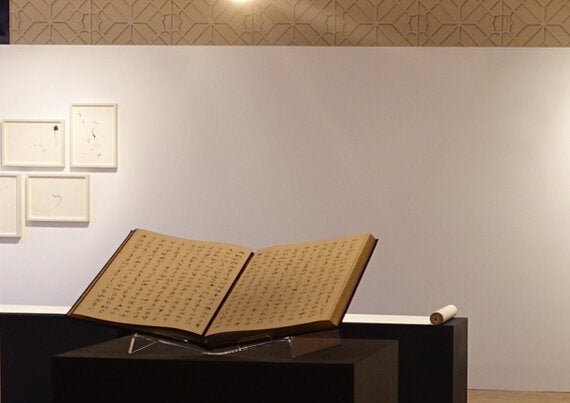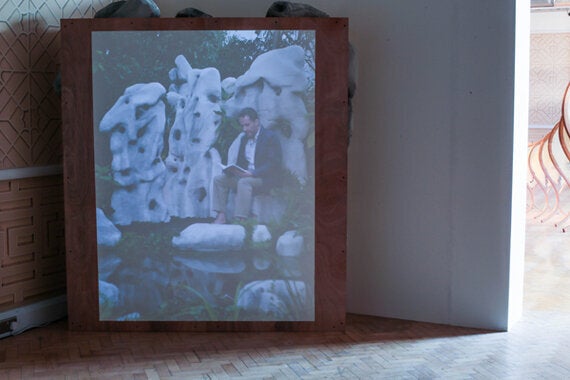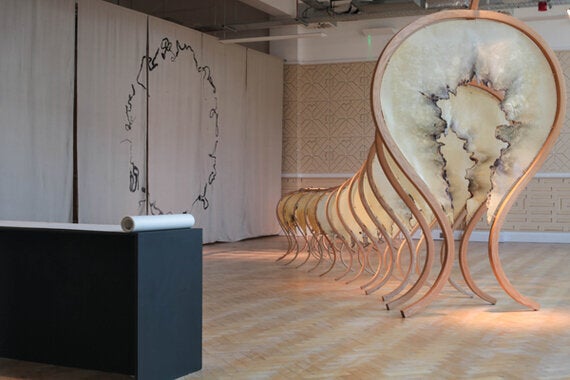A mythological creature roars in a central room, people read texts in a reconstructed garden and a beautifully bound book contains an invented language.
These are three items from an exhibition entitled Slow currently on show at the China Exchange in the heart of London's Chinatown. It's a commission from an arts initiative called Shaire, based in London, Singapore and Beijing in which interdisciplinary groups are invited to explore the broad theme of nature.
Shaire's founder, Yang Wansha, believes that the recent economic explosion in her native China and the consequent growth of huge cities there has created a distance between ordinary Chinese people and nature. She sees art as a way of trying to close that gap, particularly with Chinese families as is the way of the Chinese community in Singapore where she lived for several years.
"I think art can be a bridge between people and nature", Yang tells me. "We'd like to focus on the family. We want to present a space in which all generations can appreciate art and nature."
Yang also sees Shaire as introducing more western art to the east. In Slow, she has commissioned one Chinese and two western artists to express their take on nature and the environment.
Zhu Yingchun is an internationally known book designer and artist from Nanjing. From 2007-2014, he received the prestigious "Most beautiful Book in China" award annually.

For the past several years, Zhu has focused his artistic practice on nature's small creatures such as ants, snails and so on. His centrepiece for Slow is to combine his interests by creating a book (above) in which he has recreated in ink the patterns which these insects deposit on the leaves in his garden.
The patterns have become a new typography, a new kind of language that has no literal meaning yet has a certain aesthetic. As co-curator Jaime Marie Davis puts it, "He finds the most beautiful designs that are found in nature, so reformulating something that is happening in the world."
Similarly, though less appealing to this eye, is a huge scroll on which the artist has placed ink so inviting insects to land on it and thereby to make the patterns themselves. Zhu has worked on the scroll, or should I say the creatures have, for 12 years.

Zhu's Nanjing studio provided a residency for London-based film maker Carlos Jimenez, in particular the same adjoining garden in which Zhu found his insect patterns. Jimenez's take on nature in this exhibition is to reconstruct this traditional Chinese garden, including rocks that symbolise immortality, and use it as the backdrop to a 74-minute film (above).
The video features some 20 or so people who read texts on aspects of nature. Among them are authors, gardeners, climatologists and authorities such as the Photo Editor of Greenpeace, the Land Trust manager of Southeast England, the editor of The Plant magazine and the conservator of the V and A Museum.

The most eye-catching exhibit in Slow is by the internationally acclaimed American sculptor Aaron Distler. It comprises what looks at first like a large caterpillar but, in fact, is a Chimera, a mythical fire-eating dragon (above) that supposedly vanishes when you look at it. So it has both a physical and ethereal presence about it.
The importance of this work, as with the others, is as much in the process as in the final outcome. Distler has fashioned the legs from wood for which he has used steam to bend them into shape. While carving the wood, he follows the natural grain. The body is made from large sections of oiled paper which he has shaped by setting fire to them. Using these natural elements, he shows an appreciation of "slow design", a return to hand craftsmanship that is not always sweet but sometimes fierce..
"The fire and the steam is interesting because it's a process that is almost out of your control. It's almost a chaotic process that you're trying to contain," Distler tells me. "With the steam-bending process it's craft, you're giving yourself a tight parameter to work in which I find really fulfilling."
There are many aspects to wood, one of which, as here, is a precious material used in the manufacture of fine furniture and all manner of practical and decorative items. Yet Distler is also trying to make the viewer consider wood's more sinister side.
"It's a material in which the fibre is under tension, it's an organic material that decays. You really have to wrestle it into being something else that isn't its natural state."
Shaire is hoping to develop its London branch into a foundation and is looking for any established artists from whichever discipline to create artworks on the theme of nature which could then be shown to a Chinese audience. Slow will travel to China and open to the public during Art Beijing 2017.
In the meantime, it will show at the China Exchange, 32A Gerrard Street, London W1D 6JA until 27 September
All images are used with the permission of Shaire and the artists.